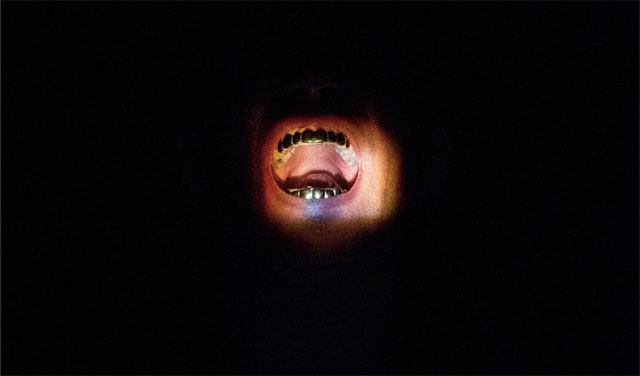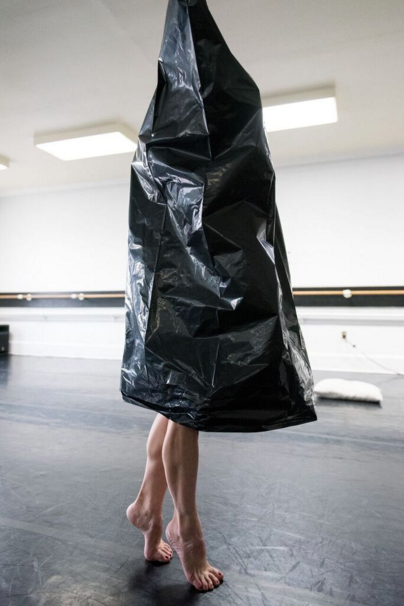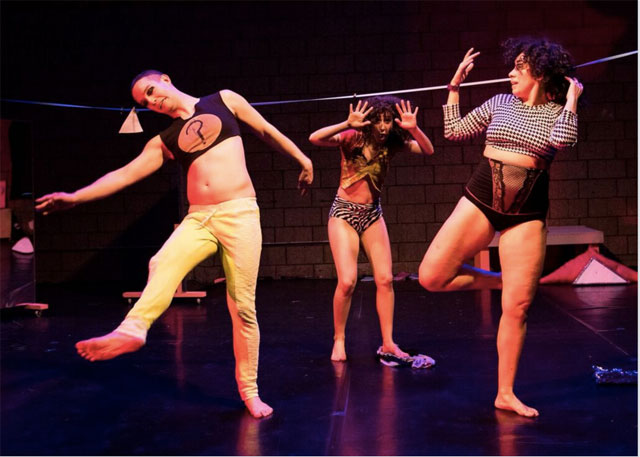
From Ligia Lewis’s Sorrow Song at American Realness Image Ian Douglas
Once a year “American Realness” takes over the Abrons Art Center to present two weeks of new and experimental dance-cum-performance. Last year, the pervasive theme running through the festival told a story of survival. It’s hard out there for an artist. This year, curator Ben Pryor assembled a group of performances focused on identity and institutional critique with a bit of self-reflexive formalism thrown in.
I saw too many performances to review, so what follows is a brief recap of my viewing, along with a few thoughts and reflections.

Heather Kravas, “Dead Disappears” Photo by Ian Douglas
Heather Kravas, Dead Disappears
An old school performance in which the dancer pairs and contrasts body movements and rhythms with known means of measuring and quantification. Concretely, that meant watching Kravas put a garbage bag over her head and walk forwards and backwards in her toes while repeating single words, chant numbers while tapping her clogs, and violently hit a pillow strapped to chair with a stick while yelling out verbs. (The latter is a reference to Richard Serra’s verb drawing.) In one part of the performance she created a beat with stop-and-start peeing in a pot.
While I marveled at Kravas’s ability to control and manipulate her body—as an audience member it’s impossible to ignore the emotions that get violently pushed through her body—ultimately, it’s not my cup of tea. “Dead Disappears” looks to the art historical past for inspiration, without ever looking forward. As a result, I was left with precious few means to connect.

Tyler Ashley, Talya Ashley, and Larissa Velez-Jackson in Star Crap Method
Larissa Velez-Jackson, Star Crap Method
Larissa Velez-Jackson and cohorts Tyler Ashley and Talya Epstein describe the “Star Crap Method” as reality-based theatre, feminism, “inner witness conditioning”, an art show, Karaoke, and practiced in the school of “un-ison”. In other words, they make stuff up real time, and narrate their methodology as they go along. Each show is different. Sometimes they flop, sometimes they never stop.
I was there for a bad day, but some of the problems would have existed even in the best run. Why, for example, did the show begin with Karaoke and end with the dancers posing as living sculpture? Who knows! It’s not like I need a guide, but if the point was “haha, look at all the half-assed stuff we can do” a little explanation would have helped.
To be fair, though, the real issue was the night’s half-dead audience. When Velez-Jackson, Ashley and Epstein invited the audience to sing Karaoke with them, no one joined. (The next day, I heard the audience was practically crawling over one another for a chance to get the mic.) Later, Velez-Jackson introduced Epstein as “a secular person with a vagina” and Ashley as someone the audience should thank because he “doesn’t identify with a gender”, no one laughed. IT WAS FUNNY. That much took place in only the first five minutes of the piece. The rest of the performance felt like an endurance event.

Erin Markey, “A Ride on Irish Cream”. Photo: Ian Douglas
Erin Markey, A Ride on the Irish Cream
Describing the success of Erin Markey’s “A Ride on the Irish Cream” is like trying to recall the logic of a dream. So little of the narrative makes sense that it’s easier to remember the feelings you had than what evoked them.
Here’s what I gleaned from “A Ride on the Irish Cream”: Reagan (Erin Markey), a young, vibrant dancer falls in love with Irish Cream (Becca Blackwell), a singing horse that’s also a pontoon boat. They both like each other’s butts. Good times abound. But, one day Irish Cream confesses that he waited two months to tell her he’s found a hidden angel. That doesn’t go over well. Then Reagan moves from Michigan to North Carolina and decides she’s homesick. Somehow all this tests their relationship, but when I looked back at my notes, I couldn’t piece together how.
Given that plot line I just described makes no sense, how did I conclude the musical was good? For me, the play’s success lay with the Markey’s use of call and response. Even when the narrative became entirely disorienting, the line to line back and forth between the two main characters could still be followed. “Let’s pretend we break up” says Reagan. Irish Cream worries he will hyperventilate but has a paper bag that will save him. Reagan insists he will die, so he then says she won’t be allowed to come to the funeral. From there the fighting just gets worse. No spoilers from us, but suffice it to say their conversation takes more than a few unexpected turns.

Biran Getnick in Ligia Lewis’s “Sorrow Swag”, Photo Ian Douglas
Ligia Lewis, Sorrow Swag
According to the program guide, “Sorrow Swag” uses texts and images from mid-century classical theatre (Beckett and Anouilh) to interrogate race, authorship, gender and grief. I wouldn’t have got that from the performance, which basically looks like what would happen if you landed shirtless soccer star Cristiano Ronaldo on a distant planet lit by a blue sun. Half the performance is just watching the show’s sole performer, Biran Getnick, cross a fog covered stage.
Eventually, Getnick speaks. “Tell me”, he says repeatedly as organ music plays behind him. Then, “I spit on your happiness”. Finally, the stage is darkened and a light shines directly over his mouth as he yells. It’s dramatic, and yet remarkably lacking in impact. I couldn’t make myself care about this tortured soul, so my mind wandered to contemplating movies with similarly cheesy sci-fi effects.

M. Lamar performs at the Abrons Art Center
M. Lamar, Destruction
I reviewed M. Lamar’s opera “Destruction” last week. I loved it. Here’s an excerpt:
There are times when the apocalypse may be warranted. That’s a statement I never thought I’d even consider making, but after seeing M. Lamar’s stunning operatic masterpiece, “Destruction” at Abrons Art Center, I’ve come around on it. (The show runs tomorrow at 10 pm and is part of the American Realness Festival.) The libretto (co-written by Lamar and Tucker Culbertson) tells a retribution story from the perspective of a black descendent of slaves. Distraught over the loss of life that occurred during times of slavery, segregation and neo-segregation, he calls the dead back to life. When they wake, they are very, very unhappy.
To read on click here.

Performance shot of “” at the Abrons Arts Center. Image by Ian Douglas.
I also reviewed Jennifer Lacey, Antonija Livingstone, Dominique Pétrin and Stephen Thompson’s “Culture Administration & Trembling” last week as well. An excerpt below:
As the headline act at “American Realness”, a festival dedicated to showcasing new and experimental dance-cum-performance, (January 7-17th.) Culture Administration felt oddly church-like. The hour-long participatory experience looks at sharing roles, exchanging ideas and taking risks. By the end, I felt lighter but also somewhat exhausted. Like most experiences I’ve had in church, many scenes required a kind of meditative endurance for which only the faithful have developed the muscles. As a doubtful believer in this world, I struggled with my own unwillingness to accept what was presented, though by the end, the piece won me over. I found myself at turns enraptured, frightened, impatient, stunned, charmed and euphoric.
To read on click here.


Comments on this entry are closed.